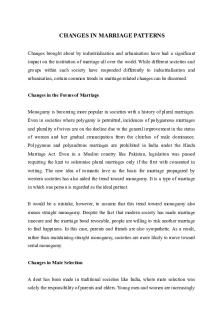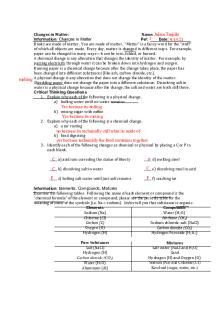William Cronon’s Changes in the Land PDF

| Title | William Cronon’s Changes in the Land |
|---|---|
| Course | StuDocu Summary Library EN |
| Institution | StuDocu University |
| Pages | 2 |
| File Size | 76.6 KB |
| File Type | |
| Total Downloads | 84 |
| Total Views | 138 |
Summary
Download William Cronon’s Changes in the Land PDF
Description
William Cronon’s Changes in the Land In Changes in the Land: Indians, Colonists, and the Ecology of New England, Cronon uses a two-pronged approach to understand how the ecological and cultural changes in New England during colonization. The changes in modes of production between Indian and European dominance are central to his thesis, which contends that the complex ecological and cultural relationships are tied directly to the influence of capitalism in early America. Capitalism drove the most robust changes in not only how the Europeans treated and organized the land, but also how the New England Indians reacted to these changes. Though, “capitalism and environmental degradation went hand in hand,” Cronon makes it a point to show that the Indians also shaped their environment, for better or for worse, just as the Europeans did. To construct an ecological history, the backbone of evidence came from descriptions made by travelers and naturalists. Part of the difficulty in using this wealth of information was judging both their naturalist skills and ideological commitments. Also, the patchwork nature of local descriptions means they cannot be perfectly representative of a regional landscape. Another source is court, town, or legislative records, but they are more vague. However, these can still be used for relatively accurate accounts of deforestation, the keeping of livestock, conflicts between Indians and colonists over property boundaries, the extermination of predators such as wolves, and similar matters. For Cronon, part of the challenge of writing this book was using ecological evidence outside of the historical discipline. For example, Ecologists have analyzed tree rings, charcoal deposits, rotting trunks and stumps to discover the history of New England woodlands. Archaeological evidence can be used to assess human interactions with their environment over time. He does a very convincing job at seamlessly weaving the different disciplines together. Changes in the Land is split into six different sections pertaining to the ecological transformations of New England. The first section focuses on Indian manipulation of the landscape before European contact. He emphasizes that while Europeans first encountering New England believed that they were seeing forests and habitats unchanged by humans, the environment had in fact been modified by the same people for over 10,000 years. Rather than being passive beneficiaries of a virgin landscape, the Indians (and later the Europeans) “sought to give their landscape a new purposefulness, often by simplifying its seemingly chaotic tangle.” The most significant instance of this was the practice of periodically burning the underbrush to make the topography more manageable on foot. The Indians of Southern New England also practiced agriculture, resulting in an ecological patchwork. The periodicity of New England’s temperate ecosystem resulted in a mobile way of life for the Indians. However, “English fixity sought to replace Indian mobility.” The Indian way resulted in more ephemeral housing and landscape alterations. When the English settled in what were empty settlements, the Indians returned with the season to find the place they knew was gone. The conflict was over two ways of living and using the seasons of the year, and it expressed itself in how two peoples conceived of property, wealth, and boundaries on the landscape. The landscape was directly affected by different concepts of property and ownership. The Indian idea of property involved co-ownership, or basically no ownership, and resulted in open forests pockmarked by communal fields tended by the women. The English idea of ownership
introduced hedges and fences, and established roads and massive pastures for domesticated animals. The deforestation that went along with the English concept of property ownership and land usage changed the ecosystem where it occurred drastically. The English saw it as the “progress of cultivation” rather than deforestation. The commodification of resources in New England based on capitalist principles not only brought colonists in large enough numbers to transfer epidemic diseases, but also changed how the Indians hunted. Before the introduction of a demand for furs, Indians took only what they needed because a mobile lifestyle did not lend itself to accumulation of wealth. This created needs and wants which were not present in the Indian mode of production before....
Similar Free PDFs

Changes in the land
- 2 Pages

Changes in the land 1
- 24 Pages

Changes IN Marriage Patterns
- 4 Pages

Changes in Matter
- 4 Pages

Joint Interests in Land
- 3 Pages

Statement of Changes in Equity
- 2 Pages

Session 4 Changes in PPC
- 6 Pages

Age Changes in Dental Tissue
- 8 Pages

5. Changes in short vowels
- 1 Pages

Statement of changes in equity
- 6 Pages

Chemical Changes Sehand IN COPY
- 13 Pages

Summary The Waste Land
- 11 Pages

The Waste Land Overview
- 14 Pages
Popular Institutions
- Tinajero National High School - Annex
- Politeknik Caltex Riau
- Yokohama City University
- SGT University
- University of Al-Qadisiyah
- Divine Word College of Vigan
- Techniek College Rotterdam
- Universidade de Santiago
- Universiti Teknologi MARA Cawangan Johor Kampus Pasir Gudang
- Poltekkes Kemenkes Yogyakarta
- Baguio City National High School
- Colegio san marcos
- preparatoria uno
- Centro de Bachillerato Tecnológico Industrial y de Servicios No. 107
- Dalian Maritime University
- Quang Trung Secondary School
- Colegio Tecnológico en Informática
- Corporación Regional de Educación Superior
- Grupo CEDVA
- Dar Al Uloom University
- Centro de Estudios Preuniversitarios de la Universidad Nacional de Ingeniería
- 上智大学
- Aakash International School, Nuna Majara
- San Felipe Neri Catholic School
- Kang Chiao International School - New Taipei City
- Misamis Occidental National High School
- Institución Educativa Escuela Normal Juan Ladrilleros
- Kolehiyo ng Pantukan
- Batanes State College
- Instituto Continental
- Sekolah Menengah Kejuruan Kesehatan Kaltara (Tarakan)
- Colegio de La Inmaculada Concepcion - Cebu


